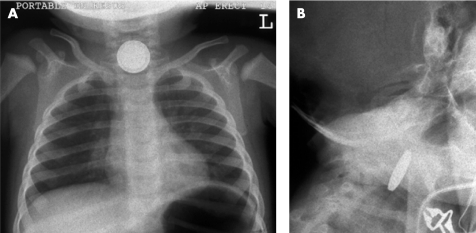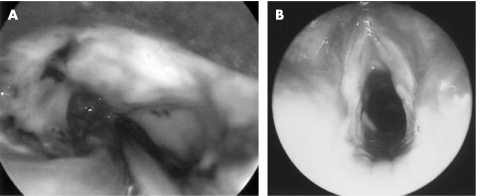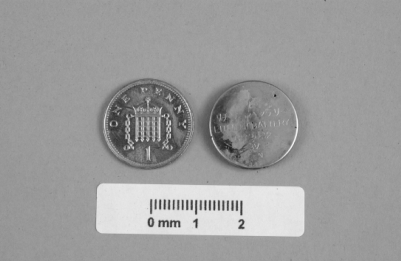Abstract
An 11‐month‐old girl with an oesophageal foreign bodywas presented: from the radiographic appearance it was presumed to be a coin. Microlaryngoscopy 5 h after ingestion revealed a button battery impacted in the hypopharynx with severe damage to the oesophageal mucosa. The patient was intubated for 6 days in the intensive care unit because of stridor and respiratory distress. Repeat microlaryngoscopy demonstrated bilateral vocal cord palsy, which was presumed to be secondary to the involvement of the recurrent laryngeal nerves in the injury. We recommend that in the absence of a history of observed ingestion, it should be assumed that coin‐like foreign bodies are button batteries until proven otherwise.
Case report
An 11‐month‐old girl developing respiratory distress was brought to the emergency department of a district general hospital with a suspected oesophageal foreign body. Anteroposterior and lateral radiographs demonstrated a round, opaque object lodged at the sixth cervical level. This was presumed to be a coin (fig 1 A,B). Owing to concerns over the safety of ambulance transfer, a consultant otolaryngologist and consultant paediatric anaesthetist travelled to the emergency department by ambulance. On their arrival the child was intubated. Approximately 5 hours after ingestion, microlaryngoscopy revealed a corroded 2 cm wide button battery lodged in the hypopharynx; corrosion injury was noted, affecting the mucosa of the anterior and lateral walls of the hypopharynx.
Figure 1 (A) Anteroposterior radiograph of the button battery in the coronal plane. (B) Lateral radiograph of the button battery in situ.
The intubated child was transferred to the Bristol Royal Hospital for Children, Bristol, UK, and admitted to the paediatric intensive care unit. Intravenous cefuroxime (200 mg three times daily), metronidazole (75 mg three times daily) and dexamethasone (1 mg four times daily) were administered, and nasogastric tube feeding was started. The following day a trial of extubation failed with inspiratory stridor and desaturation developing immediately. The baby remained sedated and intubated with a 3.5 mm endotracheal tube for a further 5 days because of concern that the erosion and swelling had spread beyond the confines of the oesophagus into the trachea anteriorly. Chest and neck radiographs demonstrated no free air.
Microlaryngoscopy at six days post‐ingestion confirmed significant corrosive injury of the anterior and lateral hypopharynx, bilateral vocal cord palsy and minimal signs of tracheal intubation trauma (figs 2 A,B). The bilateral vocal cord palsy was presumed to be due to damage to the recurrent laryngeal nerves in the tracheo‐oesophageal groove.
Figure 2 (A) Microlaryngoscopic image of the cervical oesophagus at the sixth day after ingestion demonstrating erosion, granulation and the nasogastric tube. (B) Microlaryngoscopic image of the abducted vocal cords and minor tracheal intubation trauma.
After extubation, the following day the baby remained stable on air with mild inspiratory stridor but without respiratory distress; however, there was no improvement in her voice. Arrangements were made for prolonged nasogastric tube feeding at home and follow‐up microlaryngoscopy. We anticipate the likely need for repeated balloon dilatations of the oesophageal stricture.
The foreign body was a CR2032 lithium 3 v 220 mAh battery, 20 mm wide and 3.2 mm thick.
Discussion
Button batteries, as a foreign body in children, must be treated as a medical emergency because of their rapidly corrosive action.
Button batteries are now commonplace in homes, powering small electrical devices. They are distinct from ordinary batteries because their diameter is greater than their height. There is a wide range of sizes, voltages and chemical constituents. Battery burns become severe within 4 h of ingestion, and burning can continue after removal of the battery from the oesophagus.1,2 Button batteries cause damage locally by direct pressure, leakage of corrosive alkali and generation of an electrical circuit with the surrounding tissues (electrolysis causing intracellular potassium ion release); batteries can also act distantly through the passage of toxins into the circulation.3
Button batteries have an appearance similar to coins on plain radiograph, as x‐rays are fully attenuated by the metal in both. In our case, the lodged CR2032 battery was precisely the same diameter as a one penny coin (fig 3). There are, however, subtle differences in the radiographic features of button batteries and coins. There is a halo of reduced density around the circumference of a button battery (fig 1A), and in a lateral view there is a step‐off and greater depth4 (although this can be confused with obliquity) (fig 1B).
Figure 3 Comparative image of a one penny coin and a CR2032 button cell.
Oesophageal foreign bodies can lodge at the level of the cricopharyngeus in the coronal plane, as in our case. The recurrent laryngeal nerves lie in the adjacent tracheo‐oesophageal grooves. We believe that the bilateral vocal cord paresis in our case resulted from direct bilateral nerve damage. Alternatively, it might be postulated that the vocal cord immobility was secondary to injury of the cricoarytenoid joint.
The complications of oesophageal battery burns include feeding difficulties from stricture, perforation,5 mediastinitis, damage to local nerves (the recurrent laryngeal nerves in our case) and blood vessels (potentially including aorto‐oesophageal fistula6), damage to the trachea (which may result in tracheo‐oesophageal fistula7) and death.8 In our case nasogastric tube feeding is being continued indefinitely, the girl's voice is severely compromised and mild stridor has continued although tracheostomy has not been needed.
Conclusion
We have identified no previous reports in the literature describing bilateral vocal cord palsy resulting from the lodging in the hypopharynx or oesophagus of a button battery. We highlight this rare and devastating complication. We also highlight the difficulty in distinguishing a coin from a button battery on radiographs. Unless ingestion of a coin is reliably observed, we recommend emergency department physicians and otolaryngologists assume that discoid x‐ray‐opaque oesophageal foreign bodies are corrosive button batteries until proven otherwise.
Summary box
Lodged button batteries rapidly cause direct tissue damage by pressure, and by chemical and electrical burns.
Hypopharyngeal erosion may lead to the involvement of recurrent laryngeal nerves and vocal cord palsy.
In the absence of observed ingestion, we recommend that lodged, circular x‐ray‐opaque foreign bodies be treated as corrosive button batteries (rather than coins) until proven otherwise.
Footnotes
Competing interests: None declared
Parental/guardian informed consent was obtained for publication of the person's details in this report.
References
- 1.Litovitz T, Schmitz B F. Ingestion of cylindrical and button batteries: an analysis of 2,382 cases. Pediatrics 199289745–757. [PubMed] [Google Scholar]
- 2.Wall S J, Nadel D M, Handler S D. Airway compromise caused by disk battery ingestion. Otolaryngol Head Neck Surg 1999121302–303. [DOI] [PubMed] [Google Scholar]
- 3.Samad L, Ali M, Ramzi H. Button battery ingestion: hazards of esophageal impaction. J Pediatr Surg 1999341527–1531. [DOI] [PubMed] [Google Scholar]
- 4.Maves M D, Lloyd T V, Carithers J S. Radiographic identification of ingested disc batteries. Pediatr Radiol 198616154–156. [DOI] [PubMed] [Google Scholar]
- 5.Gordon A C, Gough M H. Oesophageal perforation after button battery ingestion. Ann R Coll Surg Engl 199375362–364. [PMC free article] [PubMed] [Google Scholar]
- 6.Cheng L C, Chiu C S. Foreign body‐induced aorto‐oesophageal fistula: a review of five cases and their management. Hong Kong Med J 200612219–221. [PubMed] [Google Scholar]
- 7.Sigalet D, Lees G. Tracheoesophageal injury secondary to disc battery ingestion. J Pediatr Surg 198823996–998. [DOI] [PubMed] [Google Scholar]
- 8.Blatnik D S, Toohill R J, Lehman R H. Fatal complication from an alkaline battery foreign body in the esophagus. Ann Otol Rhinol Lryngol 197786( Pt 1)611–615. [DOI] [PubMed] [Google Scholar]





